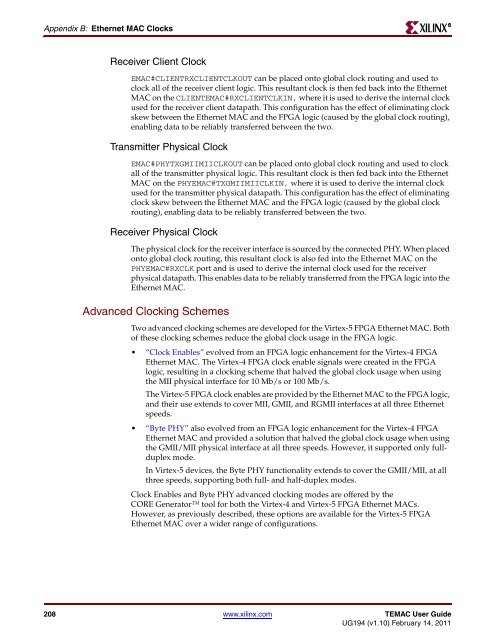Xilinx UG194 Virtex-5 FPGA Embedded Tri-Mode Ethernet MAC ...
Xilinx UG194 Virtex-5 FPGA Embedded Tri-Mode Ethernet MAC ...
Xilinx UG194 Virtex-5 FPGA Embedded Tri-Mode Ethernet MAC ...
You also want an ePaper? Increase the reach of your titles
YUMPU automatically turns print PDFs into web optimized ePapers that Google loves.
Appendix B: <strong>Ethernet</strong> <strong>MAC</strong> Clocks<br />
Receiver Client Clock<br />
E<strong>MAC</strong>#CLIENTRXCLIENTCLKOUT can be placed onto global clock routing and used to<br />
clock all of the receiver client logic. This resultant clock is then fed back into the <strong>Ethernet</strong><br />
<strong>MAC</strong> on the CLIENTE<strong>MAC</strong>#RXCLIENTCLKIN, where it is used to derive the internal clock<br />
used for the receiver client datapath. This configuration has the effect of eliminating clock<br />
skew between the <strong>Ethernet</strong> <strong>MAC</strong> and the <strong>FPGA</strong> logic (caused by the global clock routing),<br />
enabling data to be reliably transferred between the two.<br />
Transmitter Physical Clock<br />
E<strong>MAC</strong>#PHYTXGMIIMIICLKOUT can be placed onto global clock routing and used to clock<br />
all of the transmitter physical logic. This resultant clock is then fed back into the <strong>Ethernet</strong><br />
<strong>MAC</strong> on the PHYE<strong>MAC</strong>#TXGMIIMIICLKIN, where it is used to derive the internal clock<br />
used for the transmitter physical datapath. This configuration has the effect of eliminating<br />
clock skew between the <strong>Ethernet</strong> <strong>MAC</strong> and the <strong>FPGA</strong> logic (caused by the global clock<br />
routing), enabling data to be reliably transferred between the two.<br />
Receiver Physical Clock<br />
The physical clock for the receiver interface is sourced by the connected PHY. When placed<br />
onto global clock routing, this resultant clock is also fed into the <strong>Ethernet</strong> <strong>MAC</strong> on the<br />
PHYE<strong>MAC</strong>#RXCLK port and is used to derive the internal clock used for the receiver<br />
physical datapath. This enables data to be reliably transferred from the <strong>FPGA</strong> logic into the<br />
<strong>Ethernet</strong> <strong>MAC</strong>.<br />
Advanced Clocking Schemes<br />
Two advanced clocking schemes are developed for the <strong>Virtex</strong>-5 <strong>FPGA</strong> <strong>Ethernet</strong> <strong>MAC</strong>. Both<br />
of these clocking schemes reduce the global clock usage in the <strong>FPGA</strong> logic.<br />
“Clock Enables” evolved from an <strong>FPGA</strong> logic enhancement for the <strong>Virtex</strong>-4 <strong>FPGA</strong><br />
<strong>Ethernet</strong> <strong>MAC</strong>. The <strong>Virtex</strong>-4 <strong>FPGA</strong> clock enable signals were created in the <strong>FPGA</strong><br />
logic, resulting in a clocking scheme that halved the global clock usage when using<br />
the MII physical interface for 10 Mb/s or 100 Mb/s.<br />
The <strong>Virtex</strong>-5 <strong>FPGA</strong> clock enables are provided by the <strong>Ethernet</strong> <strong>MAC</strong> to the <strong>FPGA</strong> logic,<br />
and their use extends to cover MII, GMII, and RGMII interfaces at all three <strong>Ethernet</strong><br />
speeds.<br />
“Byte PHY” also evolved from an <strong>FPGA</strong> logic enhancement for the <strong>Virtex</strong>-4 <strong>FPGA</strong><br />
<strong>Ethernet</strong> <strong>MAC</strong> and provided a solution that halved the global clock usage when using<br />
the GMII/MII physical interface at all three speeds. However, it supported only fullduplex<br />
mode.<br />
In <strong>Virtex</strong>-5 devices, the Byte PHY functionality extends to cover the GMII/MII, at all<br />
three speeds, supporting both full- and half-duplex modes.<br />
Clock Enables and Byte PHY advanced clocking modes are offered by the<br />
CORE Generator tool for both the <strong>Virtex</strong>-4 and <strong>Virtex</strong>-5 <strong>FPGA</strong> <strong>Ethernet</strong> <strong>MAC</strong>s.<br />
However, as previously described, these options are available for the <strong>Virtex</strong>-5 <strong>FPGA</strong><br />
<strong>Ethernet</strong> <strong>MAC</strong> over a wider range of configurations.<br />
208 www.xilinx.com TE<strong>MAC</strong> User Guide<br />
<strong>UG194</strong> (v1.10) February 14, 2011<br />
R

















